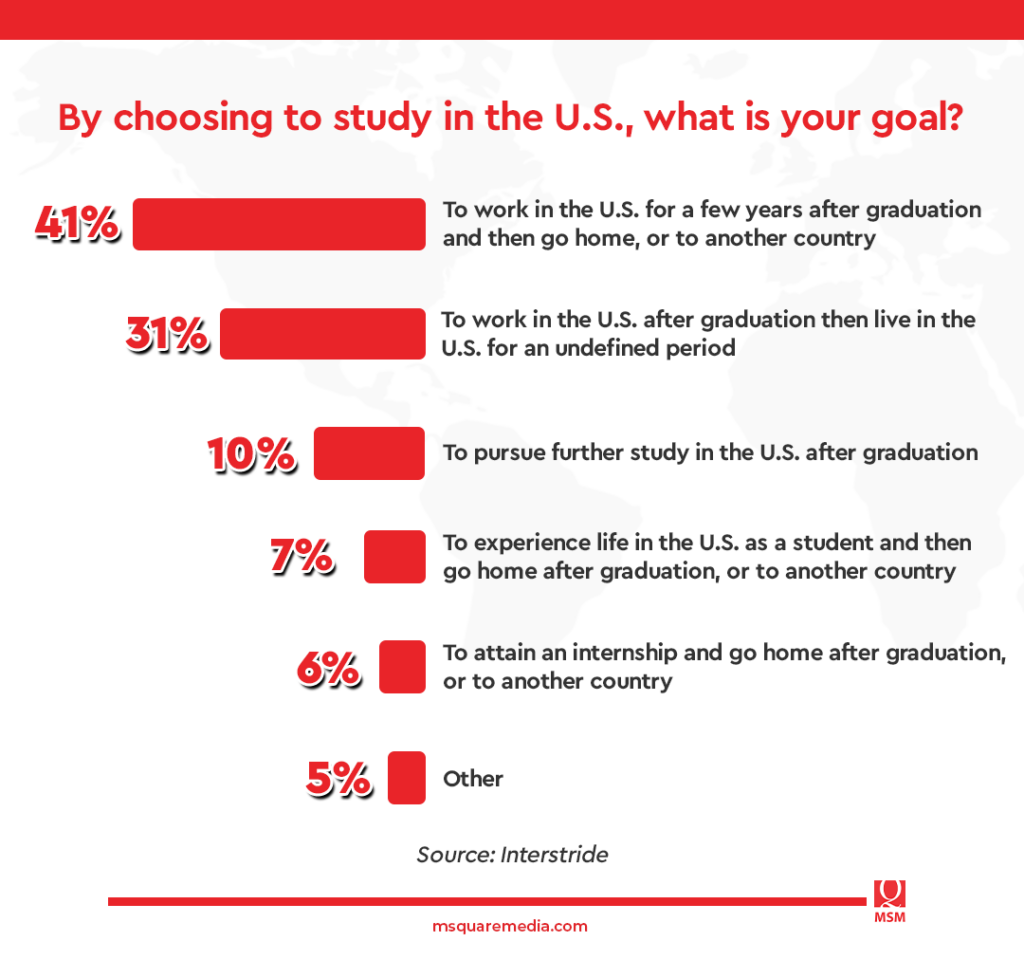Key takeaways:
- Among the reasons why international students study in the US is the quality of education, curriculum, multicultural environment, and the abundance of opportunities.
- The study revealed that 41% of international students want to work in the US for a few years before returning to their home country.
- 78% of international students believe that they will achieve their career goals by studying in the US.
There are many reasons why the United States has retained its appeal to international students who are pursuing their higher education. Quality education, a unique curriculum, a multicultural environment, and abundant opportunities are just some of the reasons why a considerable number of international students want to study in the US.
To fulfill their American education, international students must come prepared for their universities’ tuition fees which range from $37,430 to $48,510 per year on average. On top of that, students have to shoulder other expenses including visa fees, international student fees, housing, and airfare.
This begs the question, is it worth it? Is it worth the shot of achieving the goals that the students set out for themselves? Let’s look at the surveys and find out.
Student satisfaction
The 2022 survey conducted by Interstride–authored by Anna Esaki-Smith, Co-Founder of Education Rethink–titled “Is studying in the U.S. worth it? International students on the “value” of their U.S. education experience” can give us some answers. It surveyed 1,087 students on how they felt about their study-abroad experience and career exploration so far in the U.S.
When asked for their reason for selecting the U.S. over other study destinations such as the U.K., Canada, Australia, or New Zealand, 42 percent of the students pointed out the American universities’ ranking and reputation. And not surprising at all, 23 percent of the respondents showed interest in working in the U.S. after graduation.

While the institutions’ popularity is the leading reason why young people want to study in the U.S., the priority goal for these students turned out to be the working opportunities that await them when they graduate.
The study also revealed that 41 percent of the international students surveyed indicated their intent to work in the U.S. for a few years after graduation before returning to their homeland while 31 percent will be working and living in the U.S. for an undetermined time.
The confidence of these students in choosing this study destination was also highly evident–with 78 percent believing that they will achieve their goals by pursuing their education in the U.S.

Furthermore, it seems that international students in the U.S. are enjoying their experience abroad. The study also found out that a reassuring 84 percent of students would recommend studying in the U.S. to their peers back home compared to the 5 percent that stated otherwise.
The challenge in employment
Another thing that the survey showed was how these international students perceive their institutions’ services. Career centers in universities and colleges are positively viewed by international students.
When talking about their assessment of their current university career center, 81 percent of the respondents said that they were helpful in their career aspirations. However, these student centers are not being fully utilized by international students, citing only 22 percent who ranked their college’s career center as the most helpful resource for student services.

Moreover, international students’ concerns regarding the difficulty in getting jobs and internships in the U.S. cannot be disregarded. While 46 percent of survey respondents felt prepared for their career exploration in the U.S., 34 percent said they were not and 20 percent said they didn’t know.
On the flip side, among the students who said that they were not interested in working in the U.S. post-graduation, 71 percent would change their mind if getting a job in the U.S. turned out to be easier while 22 percent still didn’t know what they’d do and seven percent said no outright.
Going forward
International students’ uncertainties about their career growth in the States can be a hint for the U.S. government, institutions, international education leaders, and providers to solidify their alliances in creating and widening career pathways for the students.
Moreover, the Spring 2022 Snapshot on International Educational Exchange (IIE) survey reported that 67% of the institutions are working with agents, along with online recruitment and social media outreach, to recruit international students.
Thus, institutions must tap reliable international education agents as they play an important role in helping institutions achieve their recruitment goals.

MAY ARTHUR
Vice President, Global Marketing Office-US
May is a seasoned international education business executive with almost 30 years of experience. She has held several leadership roles dedicated to growing and retaining the international student population at partner universities.
Her broad areas of expertise include business development, organizational leadership, strategic planning, and global operations. She excels at developing and supporting partnerships with universities and managing global recruitment initiatives.
She has also been an active member of several renowned industry organizations including NAFSA: Association of International Educators, English USA, American International Recruitment Council (AIRC), and the Association of International Education Administrators (AIEA).
Sources:
- Martel, M. et al. 2022. Spring 2022 Snapshot on International Educational Exchange. IIE. Retrieved from https://www.iie.org/Research-and-Insights/Publications/Spring22-Snapshot-International-Educational-Exchange
- 2022. Most US colleges report increasing numbers of international student applications for 2022/23. icef Monitor. Retrieved from https://monitor.icef.com/2022/06/most-us-colleges-report-increasing-numbers-of-international-student-applications-for-2022-23/
- 2022. Most international students in the US want to stay after graduation but worry about getting a job. icef Monitor. Retrieved from
- 2021. International Students and Graduates in the United States: 5 Things to Know. FWD. Retrieved from https://www.fwd.us/news/international-students/#:~:text=In%20the%202018%2D2019%20school,numbers%20of%20international%20students%20overall.
- 2020. The United States of America Benefits from International Students. NAFSA. Retrieved from
https://www.nafsa.org/sites/default/files/media/document/isev-2020.pdf
- 2020. International Students in USA (by the Facts & Figures) – 2022. Admissionly. Retrieved from https://admissionsly.com/international-students-in-usa-statistics/
- Skinner, M. et al. 2019. Are the U.S. HEIs Meeting The Needs of International Students?. WES. Retrieved from https://knowledge.wes.org/rs/317-CTM-316/images/research-report-are-us-hei-meeting-the-needs-of-international-students.pdf
- Why Study in the USA? 5 Reasons & Benefits Make USA the Best. IDP. Retrieved from
https://www.idp.com/middleeast/study-in-usa/why-the-usa/?lang=en

